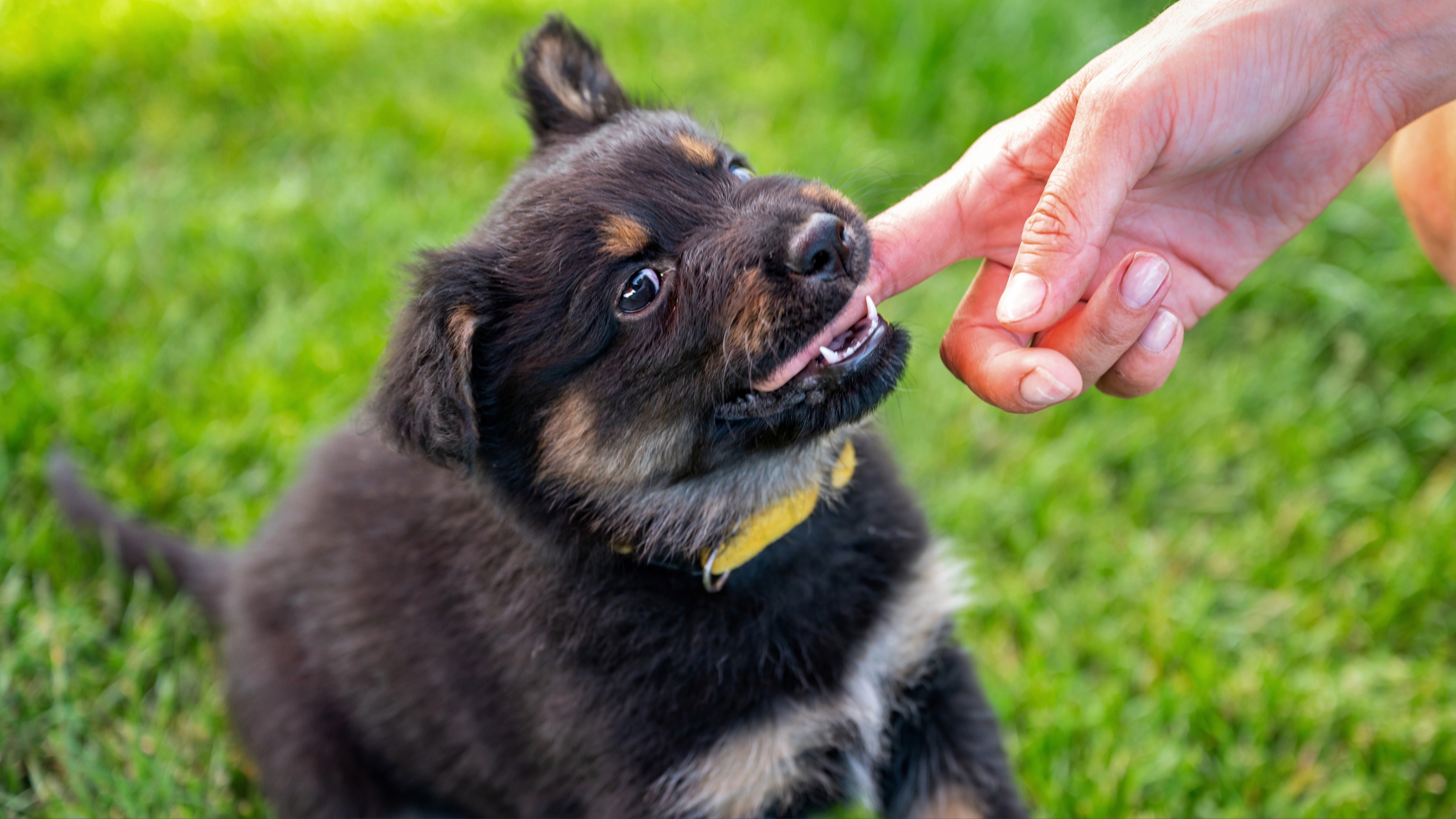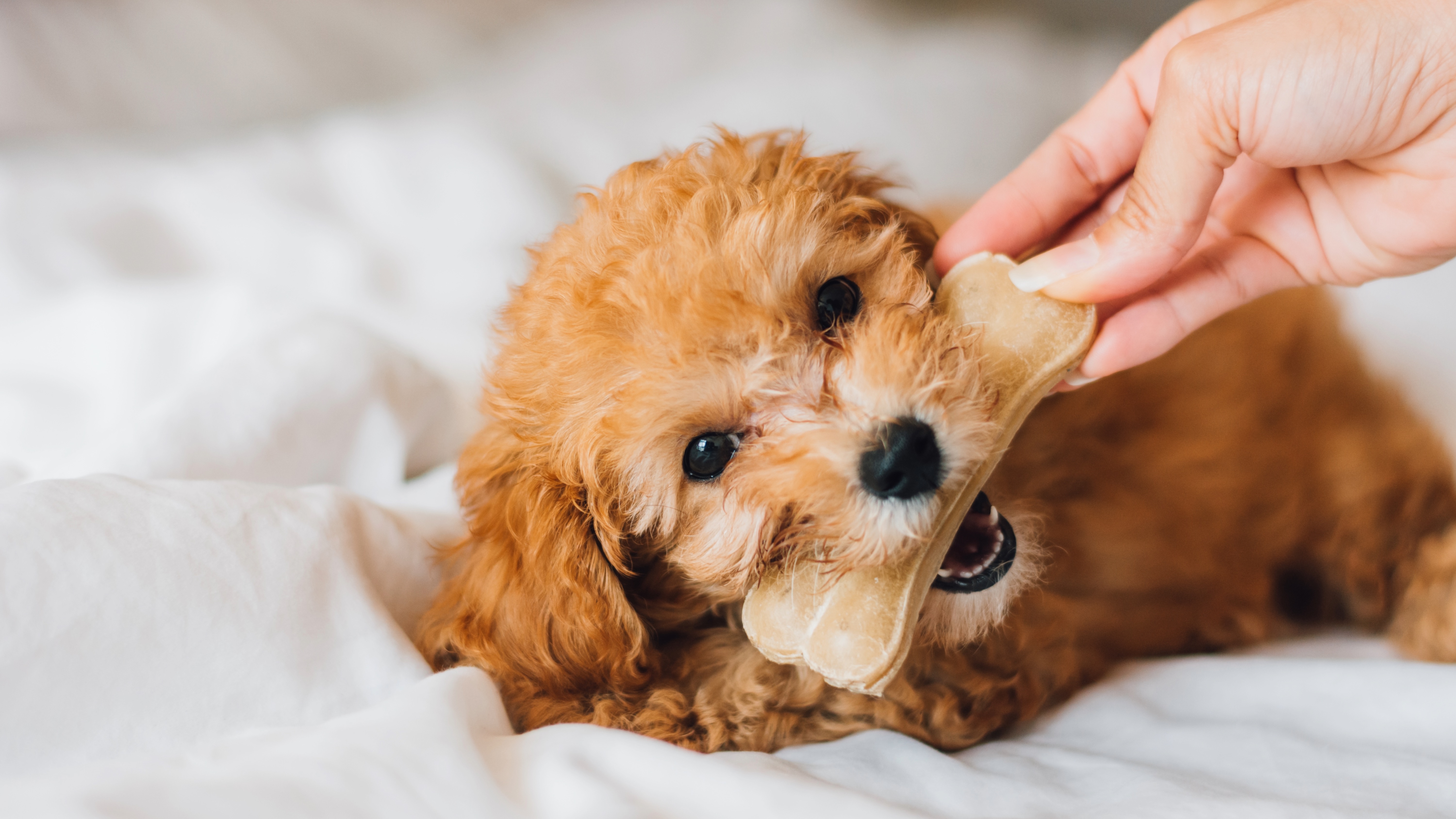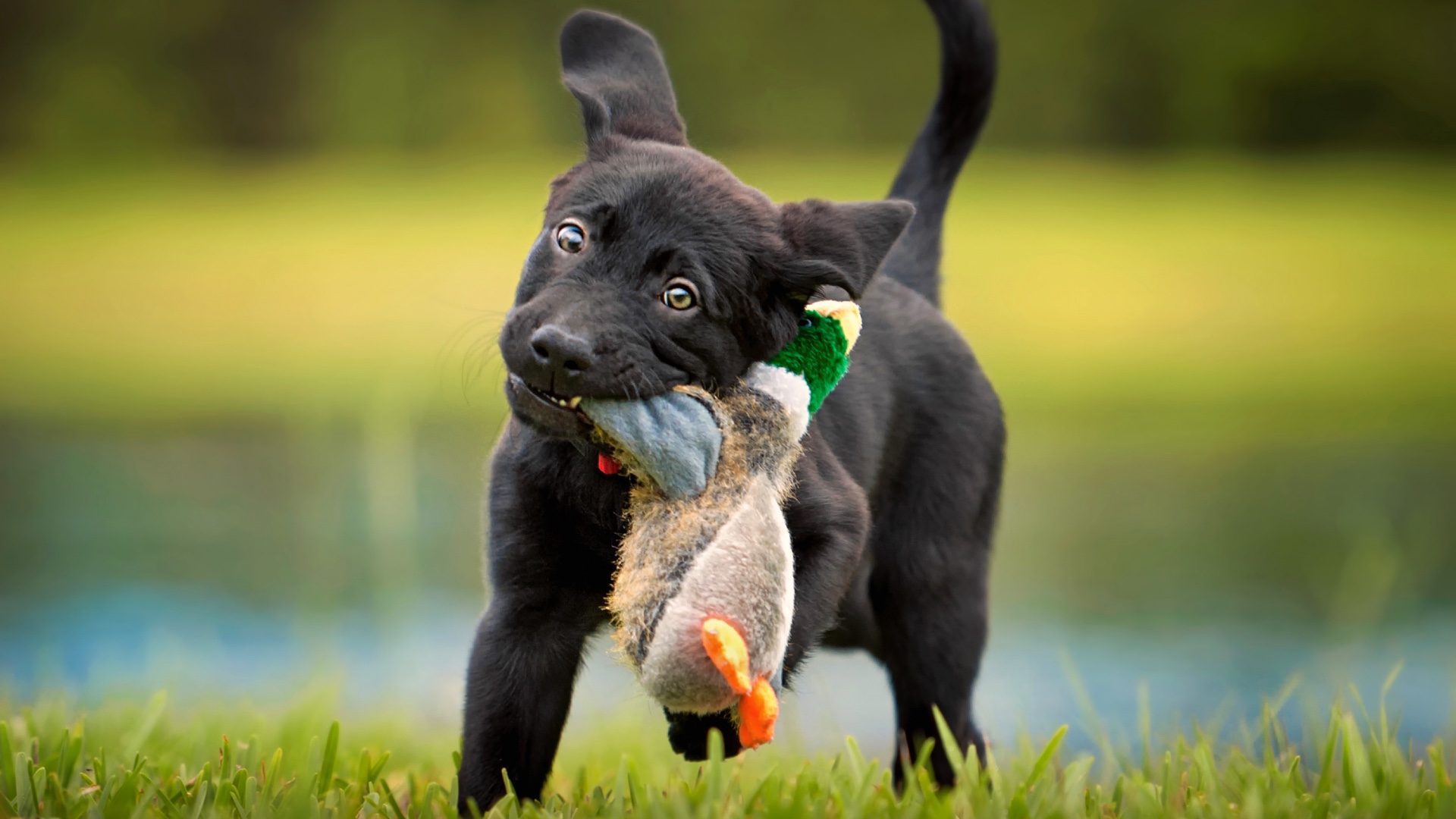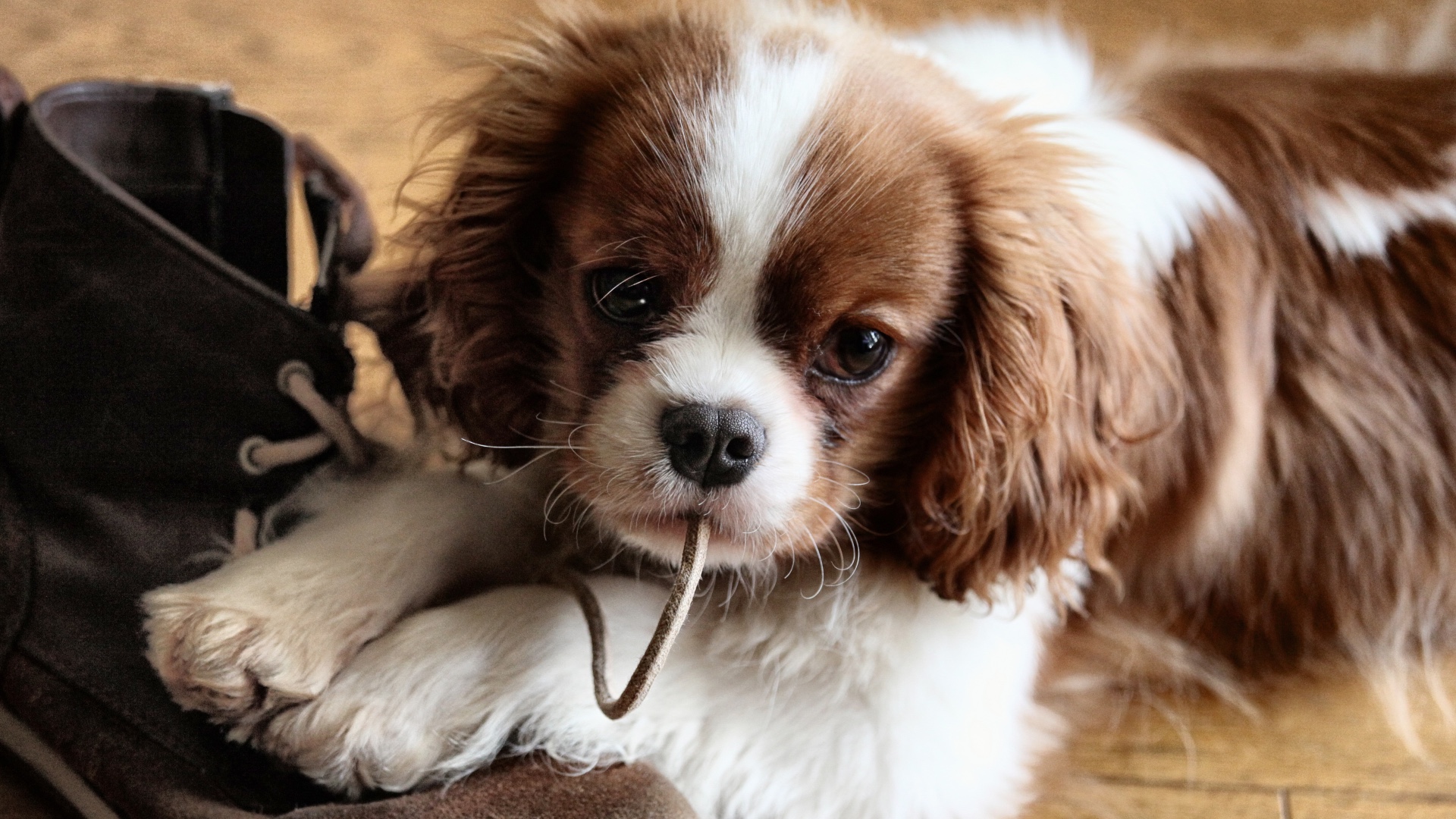Vet shares top tips on how to train a puppy not to bite (and it's easier than you might think)
Here are five great methods for how to train a puppy not to bite — all approved by a vet!

If you're anything like most new dog owners, learning how to train a puppy not to bite is likely high on your list of priorities. And it's no wonder. With a mouth full of 28 razor sharp little teeth all wanting to latch on to you, your clothes and your furniture, helping your new fur friend master the art of appropriate chewing is key.
A puppy explores the world in much the same way as a new baby does — by using their mouths. And just like children, they need to be taught what behaviors are acceptable and which ones aren't. Thankfully, teaching your little one not to bite isn't as complicated as you might think.
Stocking up on the best puppy toys, some good quality treats, and investing your own time and patience are the only tools you'll need to be successful when it comes to training this particular behavior.
To talk you through exactly how to stop a puppy biting, mouthing or nipping, we turned to expert vet Dr. Hannah Godfrey for advice. Here are five of the simplest methods you can use to curb your puppy's mouthy behavior — and they're all super effective.

Dr Hannah Godfrey studied Veterinary Medicine at the Royal Veterinary College London. After graduating in 2011, Dr Godfrey went on to become a veterinary surgeon, conducting surgery consultations on a range of animals at a small independent practice in Cardiff, South Wales, UK. Dr Godfrey has a strong interest in soft tissue surgery. When she’s not helping animals back on their feet, Dr Godfrey writes a number of veterinary and animal-focussed articles.
Why do puppies bite?
"Just like babies, puppies learn as they grow by exploring, experimenting, and being curious. They rely on others, including their mother, littermates, and eventually their new human family, to show them the ropes of what’s acceptable behavior," explains Godfrey.
"One example of this learning behavior is biting, puppies explore with their mouths, and they might experiment by playing more roughly or nipping to see what reaction they get. At around four to six months, puppies start losing their baby teeth and their adult teeth come through, so you might notice them chewing your hands or toys more at this age to manage the discomfort."
To help with this, we recommend investing in the best teething toys for puppies which will not only help alleviate some of the pain your young fur friend is experiencing but hopefully keep your home unchewed too!
Get the best advice, tips and top tech for your beloved Pets
At what age should a puppy be trained not to bite?
"Most pups don’t continue to bite as they grow as long as the biting isn't encouraged," says Godfrey. "Puppy training is an ongoing process, so start training straight away by disengaging from play and giving your pup no attention if they bite. If they are still nipping your fingers or toes after six months old, when teething should be over, it’s a good idea to get some advice from your vet.
While nipping and nibbling are common in young pups, and they might experiment with barking and growling a little, if your pup's behavior seems excessive or aggressive, it’s best to speak to your vet or a qualified behaviorist sooner rather than later."
You might also like to check out this article on puppy growling when playing which has plenty of helpful advice on what growling means and the best way to go about handling it.
How to train a puppy not to bite
1. Reinforce good behavior

The science behind positive reinforcement for dogs shows that just like us, our pups learn best when they’re praised for good behavior rather than punished for bad behavior. While it may sound simple, reinforcing the behavior you want is one of the easiest ways to train your puppy not to bite.
"If your pup is destroying your home (or your hands), it’s natural to want to shout, punish them with a timeout, or give a big negative reaction. However, this means they still have your attention, so you could actually be encouraging their behavior. Instead, focus on rewarding good behavior," Godfrey advises.
If your puppy is biting you but stops when you command them to or if you see them going for their chew toy instead of you or your furniture, issue lots of verbal praise to let them know that they’re engaging in correct behavior.
Alongside the verbal praise, you can also use some of the best puppy treats to offer them a food reward as a way of further reinforcing the kind of behavior you want to see more of.
When your puppy is showered with praise and offered treats when they do something good, they’ll soon learn to ditch negative behavior in favor of the behavior that gets them a reward.
2. Teach bite inhibition
When you teach bite inhibition to your puppy, what you’re teaching them is how to moderate the force of their bite so that they don’t clamp down on anyone in a way that could potentially cause pain or harm.
It’s incredibly important to introduce your pup to bite inhibition from a young age as once they reach adulthood their jaws become powerful enough to inflict serious damage. One biting incident is all it takes for your pooch to wind up on the dangerous dog list and can result in costly lawsuits and medical bills - things you definitely want to avoid.
If you’ve ever watched young puppies playing together, you might have noticed how a puppy will yelp if another puppy’s mouthing turns into biting. This startles the puppy doing the biting, causing them to let go, and it’s a strategy that works well for humans too.
Next time your puppy starts biting you, don’t pull away but instead, let your arm or leg go limp and imitate that same yelping sound or make a loud ‘ow’ noise. When your puppy releases you, avoid making eye contact and ignore them for around 20 seconds before you reengage with them.
You can repeat this process up to three times in a 15 minute period, but if you need to use it more than that, send your puppy for a timeout. They’ll quickly learn that biting you means they don’t get to play and this will help them learn that if they want to have fun, they need to follow your rules.
"It’s never a good idea to encourage your dog to bite, so if you're teaching your pup bite inhibition, don't skip the step where you ignore them and disengage from playing. If you yelp but then go back to playing with them, they’re less likely to get the message that biting is not allowed," Godfrey affirms.
3. Redirect their biting

"If your pup bites during playtime, redirection can be a great way to distract them while teaching them what’s okay to bite and what’s not," says Godfrey.
For this method, you’ll want to use your pup's favorite playthings to direct their biting away from you and towards a chew toy. When your puppy tries to bite you, remove your hand and instead offer them the toy. This will help them learn that biting you isn’t okay but that biting a toy is.
When they have the toy in their mouth you can also try engaging them in a game of tug-of-war, this can help make the redirection seem more fun and appealing and will condition your puppy to favor the toy and not you. Just be mindful of your pup’s teeth and jaw, which is still developing, so always make sure you tug gently.
4. Offer a distraction
While the redirection and distraction methods are similar, redirection is used as a way to work with your puppy when they’re biting you and distraction is a method to use when your puppy is biting clothes or furniture.
As with redirection, you’ll want plenty of puppy toys on hand - especially chew toys which will keep them occupied for long periods of time. We also recommend learning how to use Kong toys. These rubber toys have a hollow interior that can be smeared with peanut butter or another food paste and act as an excellent enrichment activity.
When you’re just starting out training your puppy not to bite, place toys and enrichment activities next to areas you’ve noticed they make a beeline for. Whether it’s the couch, a chair leg, or your bed, popping toys by spots your puppy likes to bite will entice them away from the object you don’t want them to bite and towards the objects you do.
"Distracting your pup with a toy or chew when they’re chewing your shoes, carpet, or furniture will help them get the message that certain things are okay to bite while others aren’t," Godfrey confirms.
5. Deter their biting

If you’ve tried all of the above methods and nothing seems to be working, it’s time to pull the most serious trick out of your magic bag – deterrence. In much the same way as parents will sometimes apply a bitter nail polish to stop their child from biting their nails or sucking their thumb, you can adopt a similar approach with your pup, just without the pedicure!
There are various sprays on the market these days that come in flavors like bitter apple and can be applied to furniture and other objects in the house to prevent your pup from biting. These sprays are non-toxic and completely safe but they have a very unpleasant taste that your baby furkid will hate.
While you can go right ahead and spray these products onto your furniture, we recommend you first introduce your pup to them so that when they come into contact with the spray, the scent alone will be enough to stop them in their tracks before they even think about biting.
The first thing you want to do before introducing your puppy to the scent and taste is to remove their water bowl for 30 minutes, this ensures that once they’ve tasted the spray they can’t immediately go and wash the taste out of their mouth. If you miss this important step your pup will learn that biting an object that’s been sprayed doesn’t matter because they can quickly wash their mouth out.
Once you’ve removed their water bowl, spray a little bit of the product onto a piece of cloth and give it to your puppy to bite into. It’s likely they’ll quickly spit it out and you can then hold the cloth up to their nose. Not only do they now know what the spray tastes like but they’ve associated that negative taste with a particular smell.
Feeling overwhelmed with everything there is to teach your puppy? You're not alone! Here's 11 reasons you have the puppy blues and what to do about it.

Kathryn is a freelance writer who has been a member of the PetsRadar family since it launched in 2020. Highly experienced in her field, she's driven by a desire to provide pet parents with accurate, timely, and informative content that enables them to provide their fur friends with everything they need to thrive.
Kathryn works closely with vets and trainers to ensure all articles offer the most up-to-date information across a range of pet-related fields, from insights into health and behavior issues to tips on products and training.
When she’s not busy crafting the perfect sentence for her features, buying guides and news pieces, she can be found hanging out with her family (which includes one super sassy cat and a kitten), drinking copious amounts of Jasmine tea and reading all the books.
She has written for a range of publications, including Fit&Well, Top Ten Reviews, LiveScience, Goodto, and Product Hunt.
